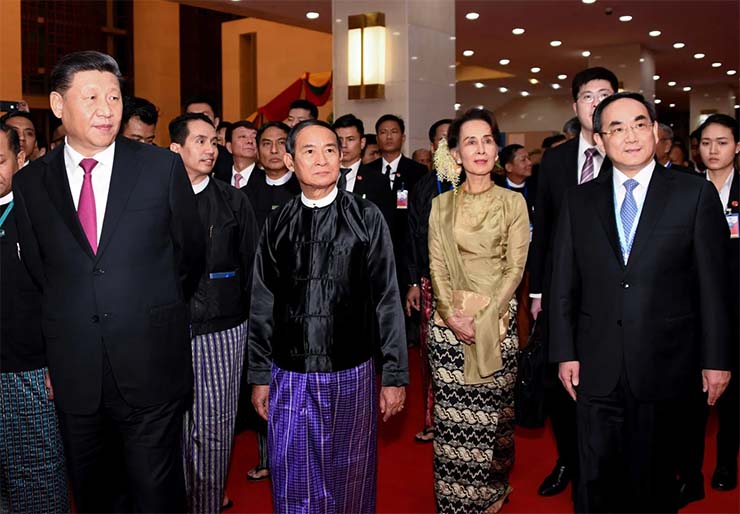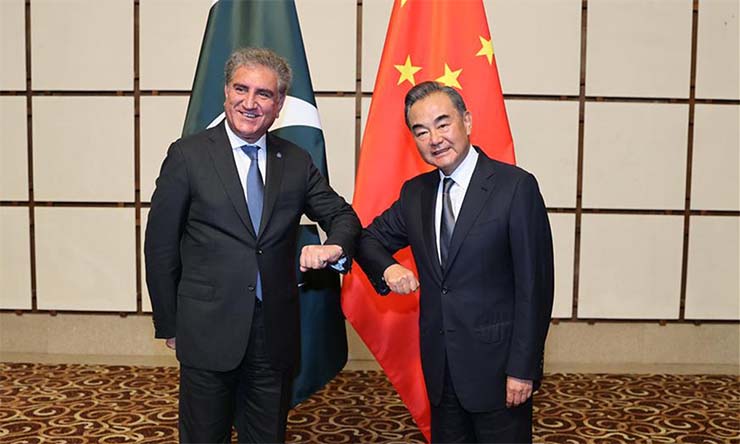
The military ties between the Pakistan army and Myanmar military junta are increasing rapidly. China, which considers India as its prospective challenger, is assisting Pakistan to strengthen defence cooperation with Myanmar. Pakistan, which considers India as its enemy, is delighted to strengthen its defence ties with the military junta of Myanmar as it feels that it has cultivated one more friend in the region. Not only this Pakistan, which has waged a low-intensity war against India, is also eager to inculcate friendship with the countries, which share borders with India. Myanmar shares a land border of about 1600 km with India, besides it, both countries also have a maritime boundary in the Bay of Bengal. India’s four North Eastern States namely Arunachal Pradesh, Nagaland, Manipur, and Mizoram share international borders with Myanmar. As both countries have strong religious, linguistic, and ethnic ties hence there is heavy traffic between both countries. The Inter Services Intelligence (ISI) of Pakistan would try to exploit the traffic. There are reports that ISI was funding, training, and supplying arms and ammunition to the insurgent groups of North Eastern States. Not only this, ISI was also sending weapons and infiltrating terrorists through these borders.
In October 2022, a high-level defence delegation from Pakistan visited the Myanmar defence industry complex near Yangon secretly. During the visit, the Pakistani delegation proposed that Pakistan can extend assistance to the Myanmar army in the repair and maintenance of aircraft. The visit of the Pakistani defence delegation was at the behest of China as Myanmar is using JF-17 jets, which are manufactured in China’s Chengdu Aerospace Cooperation and assembled in Pakistan Aeronautical Complex although Islamabad claims that JF-17 was developed by both countries. These planes were purchased from Pakistan. JF-17 has the capability of ground attack as well as combat in the air. It can deliver bombs as well as precision-guided munition such as smart bombs, smart munition and smart weapons. These fighter planes suit Myanmar’s military regime as they have to suppress indigenous dissension and agitations.
The visit of the defence delegation is significant because, after the withdrawal of the US-led NATO troops from Afghanistan, China is trying to enhance its influence in various countries, especially in neighbouring countries, directly or through its proxies.
Pakistan’s police are also training Myanmar police officers in mine disposal in Karachi. Eight officers of the Myanmar police were trained during September 10-30 in Karachi in explosives and mine disposal techniques.
A high-level defence delegation from Pakistan also visited Myanmar in the first week of September 2021. The visit of the delegation, headed by a brigadier, was not announced. The Pakistani delegation reached Myanmar on September 1 and left the country on September 5 in 2021. During the visit, officers of both countries discussed the exchange of advanced ordnance technology, aircraft repair and maintenance and naval munitions. According to reports, now both countries are in the final stages of discussion about the building of third-generation aircraft under licence.
The relations between Pakistan and Myanmar became tense when Myanmar evicted Rohingya Muslims forcibly. There are reports that in 2018 Myanmar embassy in Pakistan spent a huge sum to provide security to the embassy and its staff as there were reports that Islamic extremists would be targeting Myanmar embassy personnel due to atrocities committed on Rohingya Muslims in Myanmar. At that time, there were demonstrations and protests in several cities of Pakistan against the Myanmar government. Not only this, there were reports that ISI imparted weapon training to Rohingya Muslims residing in Cox Bazar, Bangladesh. However, China which wants to develop its influence in the world, especially in neighbouring countries, pressed both countries to have cordial relations.
Min Aung Hlaing, a senior army general, also visited Pakistan Aeronautical Complex in Kamra in 2015. Now Islamabad also wants to inculcate friendly relations with Myanmar as Pakistan can export arms and ammunition to Myanmar, which is facing several sanctions from the democratic world.
China’s Special Envoy Sun Guoxiang also visited Myanmar and met with senior military officials including General Min Aung Hlaing. China and Pakistan both want to develop close relations with military rulers as both these countries feel that the military would continue ruling the country and democratic government would not come soon in Myanmar. Hence Pakistan would enhance its defence ties with the military rulers of Myanmar.

There is an intense anti-China feeling among the masses in Myanmar hence Beijing wants that Islamabad imparts training to Myanmar armed personnel. As Pakistan has also a large number of Chinese weapons and platforms it can assist Myanmar in its maintenance, training, and sale of spare parts. China is using Pakistan not only for arms export but also wants to export other materials, which it is finding difficult to export due to massive anti-China sentiments among the masses. Chinese state-owned companies illicitly occupied the land of the farmers at the time of the implementation of FDI in oil and gas projects in Myanmar. The oil and gas pipeline ran between Kyauk Phyu in Rakhine state to Nam Kham, a town near China border. The Myanmar masses feel that China is a supporter of military rulers hence the public has attacked and destroyed the Chinese properties in Myanmar.
China also does not want to export armaments to Myanmar as it does not want to show that it is supporting the military rulers who would be using these arms to suppress the democratic forces. It would damage its international image.
There are reports that the Myanmar military is planning to purchase 60- and 81-mm mortars, heavy machine guns and M-79 grenade launchers, and would also acquire air-to-surface missiles from Pakistan.
The report of the Stockholm International Peace Research Institute (SIPRI) mentioned that China’s share of arms export in the world market has dwindled from 5.5 to 5.2 per cent but the reality is that now China is exporting arms through its proxy Pakistan. In 2020, Indian customs officials on the basis of intelligence detained a ship, which was coming from Jiangyin Port in China and was going to Karachi. The ship was carrying an autoclave, which can be used to launch ballistic missiles.
The analysts claim that Pakistan at the behest of China is focusing beyond the export of military hardware to Myanmar, which is ruled by the military junta. The ISI also wants to use ports built by China in Myanmar and it wants to infiltrate Islamic terrorists through Myanmar as Indian security forces have tightened the security on Indo-Pakistan borders. Pakistan is getting assistance from Aye Ne Win who is the grandson of General Ne Win and is close to ISI and Myanmar army rulers. The construction of the China-Myanmar Economic Corridor (CMEC), which links China with Myanmar, is going on with good speed. Chinese can use the land route as well as the sea route through the naval base Sittwe against India.
Although China considers the USA its enemy number one, it also knows that India is its opponent in the region. It wants to encircle India through its neighbours and hence it is rendering all types of assistance including military hardware to Myanmar. Beijing is exploiting its natural resources as well as its strategic location.
At present, the world is involved in the Russia-Ukraine war, and China taking advantage of it, is assisting the military rulers of Myanmar sometimes directly but most of the time through its proxy i.e., Pakistan. However, anti-China sentiments are increasing in Myanmar and once a democratic regime is established in the country people may boycott not only China but Pakistan too.
However, India should be cautious as ISI would use Myanmar for infiltrating terrorists and supplying arms and ammunition to terrorist outfits operating in India. Delhi is able to control several secessionist groups operating in the North Eastern States. ISI would certainly try to support them so that law and order deteriorate in these states. China, which is developing ports and other infrastructure in Myanmar, may also use them against India if needed. At present, Indian security planners are worried because of the nexus between China and Pakistan, the situation would be more dangerous if Myanmar also joins China and Pakistan against India.
-The writer is a Delhi-based strategic analyst and Life member of United Services Institute of India and member of Manohar Parrikar Institute for Defence Studies and Analyses. The views in the article are solely the author’s.








